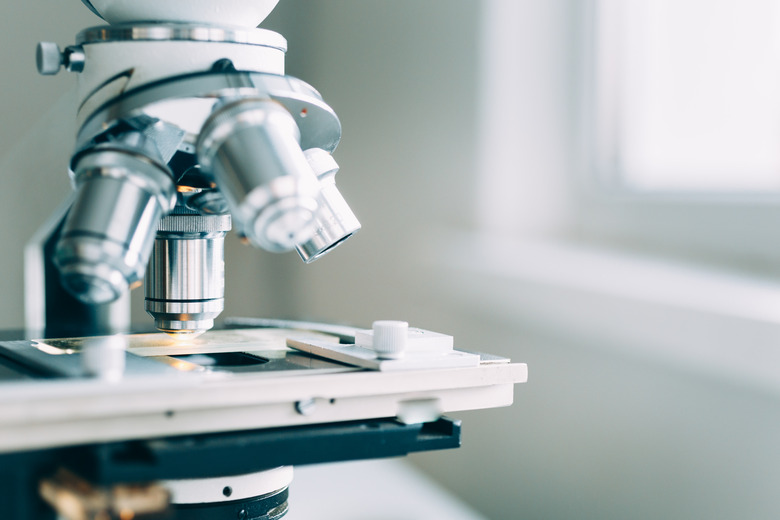What Is The Advantage Of Using Stains To Look At Cells?
The complexity of a tissue can be seen in the different shapes, sizes and arrangements of the cells. The advantage of using stains to look at cells is that stains reveal these details and more. The arrangement of cells within a tissue reveals the health of that tissue. Multiple stains can used simultaneously to mark different cells by different colors. A wide variety of chemical stains and antibody-based stains are available. The intensity of these stains – that is, the darkness or lightness of the color – can be varied according to the researcher's preference. Lastly, the color of these stains lasts indefinitely and can be easily stored at room temperature.
TL;DR (Too Long; Didn't Read)
The arrangement, shapes and sizes of cells within a tissue reveals the health of that tissue. The advantage of using stains to look at cells is that stains reveal these details and more. Abnormally shaped or abnormally arranged cells will be evidence of disease.
Multiple stains can be simultaneously used on a tissue, such that different cell types appear in different colors. Visualizing more than one protein at once gives the researcher more information. A major advantage of using chemical stains on cells is that the stain can last indefinitely. Certain methods will allow a thin slice of tissue that has been stained by chemicals to be preserved for many years.
Chemical stains can do more than visualize cells in different colors; the darkness or lightness of the color can be altered as well. This will give researchers even more information about the cells.
Structure Suggests Function
Structure Suggests Function
Stains are excellent at revealing the cellular structure of a tissue. A rule of thumb in anatomy and physiology, which employs many chemical stains, is that structure goes hand in hand with function. This means that the shape and arrangement of cells in a tissue will make clear the functions of the cells in that tissue. It also means that abnormally shaped or abnormally arranged cells will be evidence of disease. Some stains specifically target molecules that are highly abundant in specific types of tissue, such as neurons and cartilage. Others are general stains that add color to every cell. Each stain is useful in its own way for understanding the structure and function of tissues.
Multicolored Labeling
Multicolored Labeling
Multiple stains can be simultaneously used on a tissue, such that different cell types appear in different colors. Tissues often contain multiple compartments right next to each other. The cells in each compartment serve a different function, such as producing certain proteins or anchoring the outer walls of a vessel to the rest of the tissue. Multicolored labeling allows a researcher to visualize at least two different proteins at once. Certain proteins may indicate that the tissue is healthy; others that it is diseased. Visualizing more than one protein at once gives the researcher more information.
Long-Lasting Stains
Long-Lasting Stains
A major advantage of using chemical stains on cells is that the stain can last indefinitely. Chemical stains, or chemical stains used in combination with antibodies, tracking proteins that bind to only one type of protein, are applied to thinly sliced tissue. This slice of tissue is attached to a thin glass slide. After the staining is complete, a mounting liquid is dripped onto the tissue and the tissue is sandwiched by a glass cover slip. Mounting liquid, also called mounting medium, turns into a clear solid when exposed to air. Because of this, a thin slice of tissue that has been stained by chemicals will be preserved for many years.
Varying Stain Intensities
Varying Stain Intensities
Chemical stains can do more than visualize cells in different colors; the darkness or lightness of the color can be altered as well. The degree of staining is referred to as intensity. Dark staining is high-intensity staining; light staining is low-intensity. Two categories of stains allow a researcher to vary the staining intensity. Progressive stains make cells darker the longer the cells are exposed. Regressive stains color a cell, but the intensity can be can be decreased by gradual washing with water.
Cite This Article
MLA
Ph.D., David H. Nguyen,. "What Is The Advantage Of Using Stains To Look At Cells?" sciencing.com, https://www.sciencing.com/advantage-using-stains-look-cells-19317/. 1 May 2018.
APA
Ph.D., David H. Nguyen,. (2018, May 1). What Is The Advantage Of Using Stains To Look At Cells?. sciencing.com. Retrieved from https://www.sciencing.com/advantage-using-stains-look-cells-19317/
Chicago
Ph.D., David H. Nguyen,. What Is The Advantage Of Using Stains To Look At Cells? last modified March 24, 2022. https://www.sciencing.com/advantage-using-stains-look-cells-19317/
